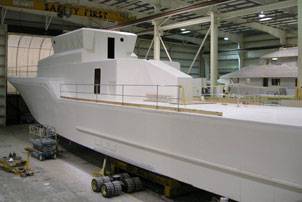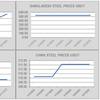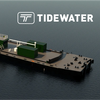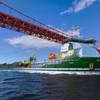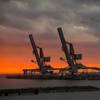Westport Shipyard on the Future of Government Craft
By Raina Clark, from MarineNews September 2010
Westport Shipyard of Westport, Wash. recently launched its Global Response Cutter (GRC-43) prototype, constructed of a composite material the company believes to be the future of boat building. The launching of the 143-ft vessel also marks the yard’s return to commercial boat building. Westport Shipyard began in 1964, building commercial fishing vessels for the Northwest fleet and the occasional pleasure boat. In the early 90s Westport built the high-speed ferries for the Catalina service, but shortly afterward the company segued over to serving the yachting industry exclusively. Philip Purcell, vice president of Westport Shipyard, said the yard went into pleasure crafts because the market was very fragmented and undisciplined. The yard saw an opportunity to offer an off-the-shelf solution.
When Westport began building composite yachts, Purcell explained, “Everyone said we were out of our minds. But we built over 50 112-ft yachts, 32 130-ft yachts and seven 164-ft yachts. We have over a hundred [composite] boats around the world.”
Westport’s design strategy consists of identifying what configurations work best, engineering a vessel once, building it repeatedly and tweaking it slightly as user feedback comes in. “Our objective was to build a series-built boat, a predictable product for a predictable price and in a predictable time frame.”
Seeing that the government and military market was now plagued by over-time and over-budget vessel deliveries, just as the yachting market had been, Westport believed government customers would also benefit from the series-built approach and the composite hull. With the GRC-43, Purcell said Westport created a “predictable boat” for U.S. agencies such as the Navy, Coast Guard, Special Operations, Homeland Security and foreign military.
Purcell also noted how government agencies are also grappling with budget cuts and the high maintenance and life-cycle costs of their boats. “Life cycle costs are killing our government and other governments because it’s so expensive to maintain boats over so many years,” Purcell said.
Using the composite construction that Westport has demonstrated for years in the yachting industry, Purcell said his yard can provide the solution. The advantages of the composite material, he said, includes a superior weight to strength ratio, distinct thermal advantages and non-corrosive properties. This reduces costs associated with hull coatings and fuel and increases operational time.
“The strength and tolerances of composite are just tremendous,” Purcell said. “It’s stronger and lighter than aluminum and steel.”
“We used the aviation industry as our model,” Purcell pointed to the acceptance of composite construction in air craft. He said an off-the-shelf composite solution has been offered as the Boeing 787 and welcomed by the airlines. “The objective there is a better aircraft at a more predictable cost. You don’t change the fuselage, you don’t change the wings,” he said, you build a mold based on a proven design and produce a series of crafts.
The composite material is not yet main stream in the boatbuilding world. While Purcell believes composite is the future of boat building, he understands the technique starts with a bigger price tag. “There’s a huge investment upfront to build the tooling (molding) before you build the boat. With aluminum and steel you just buy the metal and cut it as needed.”
“The GRC prototype is fully operational with electronics, ready to be delivered to some military somewhere in the world,” Purcell said. The vessel is now crewed by Westport staff and has moved to Port Angeles, Wash. where it can more easily accept visitors and potential buyers. “We’re planning to campaign it down the West Coast, through the Panama Canal and up the East Coast to show people that this is for real.”
“We are the only composite series, off-the-shelf builder for commercial customers in the U.S,” he said. Purcell explained that there are three other builders that actively use composite in the U.S., but they are in the yacht market and produce custom builds.
“We funded this project ourselves. This is a long-term commitment for us to help re-educate the market,” he said. The GRC-43 was built to U.S. Coast Guard requirements, using American Bureau of Shipbuilding (ABS) rules for high-speed craft. The Westport yard can deliver six GRC cutters a year. The company employs about 700 people total, between its facilities in Washington State and its service facility in Ft. Lauderdale, Fla.



